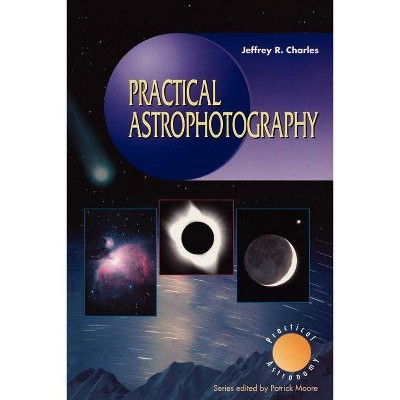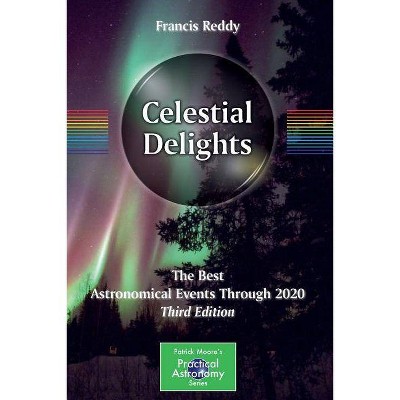Guidebook to the Constellations - (Patrick Moore Practical Astronomy) by Phil Simpson (Paperback)

Similar Products
Products of same category from the store
AllProduct info
<p/><br></br><p><b> About the Book </b></p></br></br>This handbook guides the stargazer through all 88 officially recognized constellations, grouped according to their origin and location in the sky. The book includes origin myths, finder charts, tables, photographs, and plots of binary star orbital motions.<p/><br></br><p><b> Book Synopsis </b></p></br></br><p>This handbook is a guide to exploring the classical night sky and its wonderful telescopic sights. All 88 officially recognized constellations are presented in natural groups which are related by their origin and location in the sky. Each group is explained by a fascinating story which tells what each constellation represents, how it appears in the sky, and why the other constellations of the group are close by, or related in some other manner. Some of these stories are classical myths which show how and why ancient cultures saw the constellations as related groups. Others are about more modern astronomers who sought recognition by filling in the gaps between the ancient constellations with inventions of their own. Both types of stories are crafted to make the constellation groups memorable, so that amateur astronomers can not only locate and recognize the constellations more easily, but also be able to pinpoint the celestial objects they contain more quickly.</p> <p>Specific instructions are given for finding each constellation, how to spell and pronounce the constellation and star names, plus the origins of the star names. Finder charts show each constellation group and a large area of sky around the group. These charts also indicate pointer stars which aid in finding the constellations.</p> <p>More detailed charts show how each constellation figure is visualized through simple line drawings. For each constellation, there is a table of about 10 to 30 telescopic objects selected to include a wide range of difficulty. Some can be glimpsed with the unaided eye, others require a 12 or 14 inch telescope. All the most prominent telescopic objects are included, plus a varied selection of interesting, but much more difficult objects. The tables include each object's celestial coordinates, type, size, brightness, other information specific to each type of object, and a recommendation of the appropriate telescope size needed for good viewing.</p> <p>There are also photographs of constellations and telescopic objects, detailed locator charts for the hard-to-find objects, and plots of binary star orbital motions. The same charts used to show the constellation figures are repeated, with the addition of symbols indicating the locations of all the selected telescopic objects.</p> <p>An index and seven appendices help the user find specific objects or classes of objects.</p><p/><br></br><p><b> From the Back Cover </b></p></br></br><p>This handbook is a guide to exploring the night sky and its wonderful telescopic sights. All eighty-eight officially recognized constellations in both hemispheres are presented in natural groups, related by their origin and location. The author, a former astronomy instructor and planetarium director, has for over thirty-five years, researched myths from all over the world to identify the most memorable stories which link multiple constellations in a single story. Thus, the interested observer may discover that it will be easier to use already known constellations to locate and remember new constellations. The author has found that showing each constellation figure with a simple line drawing is helpful for remembering each constellation. He includes photographs of many of the brighter celestial objects, as well as many accompanying drawings which illustrate how the telescopic views differ from the photographs. </p><p>One way to use this handbook, which is useful to beginners as well as experienced astronomers, is to read the myth or story that explains the constellation of interest, view the corresponding photograph, finder and detailed charts, and then go outside and find it! This method was successfully used with groups ranging from third graders to college astronomy classes. An index and seven appendices help the user find specific objects or subjects of interest. Other helpful features of this comprehensive guidebook include: <br></p><ul><li>Specific instructions for finding each constellation</li><li>A list of the named stars in each constellation with the correct spelling, pronunciation, and origin of the star names</li><li>Finder charts showing each constellation with a large area of the sky around it</li><li>Detailed charts showing the location of the celestial objects in each constellation</li><li>Constellation photographs</li><li>Pointer stars and special star groups which can be used as aids in finding specific constellations</li></ul><p/><br></br><p><b> Review Quotes </b></p></br></br><br><p>From the reviews: </p><p>"The book goes through each of the 88 constellations in use and also mentions some obsolete ones as well. ... This book also gives a lot of information about the various objects that might be of interest while observing the sky with a telescope - the tables include multiple stars, variable stars and star clusters where you can for example look up their magnitudes and spectral classes. ... Overall it's an excellent handbook to go through while looking for something to observe." (Kadri Tinn, AstroMadness.com, December, 2013)</p><p>"This book ... combines Simpson's experience of presenting the night sky to beginners with photographs and drawings by 13 other amateurs around the world. The result is a meaty tome of well over 850 pages, packed with information and illustrations that should keep any enthusiastic observer of the night sky busy for years. ... I can heartily recommend this book to all those learning their way around the sky, and who appreciate knowing the ancient stories of the stars as well as the modern science." (Ian Ridpath, The Observatory, Vol. 132 (1230), October, 2012)</p><p>"Guidebook to the Constellations is intended for observers wanting to move beyond a casual glance at the heavens. ... The book provides the visual depiction of each constellation in two different sketches, along with an image of the sky of the region. ... The book is illustrated with images from amateur astronomers. The appendixes provide an excellent summary of helpful definitions and reference material. Summing Up: Recommended. General audiences and lower-division undergraduates." (D. E. Hogg, Choice, Vol. 49 (11), July, 2012)</p><p>"The author has grouped those together which share common origins and myths to tell the tales and which can then be learned as a unit. ... There are plenty of images, all taken by amateurs, and, interestingly, many are shown both in their original format and processed to give the appearance in a medium sized telescope. ... the price and number of pages, it seems good value and very informative for those who want a single reference to the constellations and their objects." (Jonathan Gale, Plain Astronomy, Vol. 1 (1), March, 2012)</p><br><p/><br></br><p><b> About the Author </b></p></br></br>An active amateur astronomer for over 40 years, L. Phillip Simpson has worked as an instructor of astronomy at four different universities and colleges. During the 1980s he was Director of the Clyde W. Tombaugh Space Instruction Center. More recently he worked for Northrop Grumman as Product Team Leader for design and production of telescopes for the Space Based Infrared System. He is currently a part-time assistant at NM Mexico Skies (a leading guest observatory and internet telescope provider), instructing astrophotographers and visual observers.
Price History
Price Archive shows prices from various stores, lets you see history and find the cheapest. There is no actual sale on the website. For all support, inquiry and suggestion messagescommunication@pricearchive.us




















